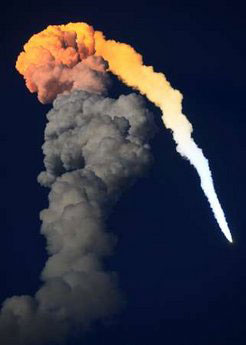|

The space shuttle Discovery rockets skyward as its contrail is illuminated by the late afternoon sun at the Kennedy Space Center in Cape Canaveral, Florida March 15, 2009. [Agencies]
|
The shuttle rode into the clear sky trailing a column of pale smoke that turned into a knot of bright pink as it caught the light of the setting sun. Two and a half minutes into its climb to orbit the ship dropped its booster rockets, which could be seen drifting back to Earth as pinpoints of light against the darkening sky.
Discovery will spend the next 13 days in orbit, speeding around the Earth at 17,500 miles per hour. For eight of those days it will be lodged at the space station, which is nearing completion after more than a decade of construction 225 miles above Earth.
The space station is about 75 percent complete. When it's finished it will be larger than a full sized soccer field.
The primary goal of the mission is to deliver the last piece of the station's 11-part external backbone, the structural spine of the $100 billion outpost.
FULL POWER
The $300 million truss segment in Discovery's cargo hold contains the final set of solar wing panels to bring the station up to full power, with 120 kilowatts of electricity -- enough to power 42 homes of 2,800 square-feet.
"That's a pretty healthy neighborhood," said NASA spokesman Allard Beutel.
The power boost will pave the way for NASA and its 15 partners to double the station's crew size from three to six members as early as May.
Japan's tenure as a prime station operator begins sooner. Discovery's seven-man crew includes Koichi Wakata, 45, who will be left behind on the space station as Japan's first resident crew member. NASA last year delivered and installed the main components of Japan's Kibo laboratory at the orbital complex.
"It is over 20 years since Japan started this endeavor, in participating in the International Space Station program," Wakata, a veteran of two previous shuttle missions, said in a preflight interview.
"To be able to conduct a variety of experiments, we need to be able to stay on board the space station on a long duration," he said. "I am very fortunate to be able to participate in a long-duration flight to fully utilize the Kibo module."
Joining Wakata are commander Lee Archambault, 48; pilot Dominic "Tony" Antonelli, 41; flight engineer and lead spacewalker Steven Swanson, 48; spacewalkers Joseph Acaba, 41, and Richard Arnold, 45; and John Phillips, 57, who already has served as a resident space station crewmember.
The crew plans to conduct three spacewalks to hook up the new solar wings and prepare the outpost for future additions.
Discovery also will be delivering parts to fix the station's water purification system, which recycles urine and condensate into clean water for drinking. The system was delivered during the shuttle's last mission in November, but stopped working shortly thereafter.
NASA has eight flights remaining to complete space station assembly before retiring the shuttle fleet next year. A proposal to fly a ninth mission to the station to deliver a dark matter experiment is pending before Congress.
The US space agency also plans to fly a final servicing call to the Hubble Space Telescope in May.

